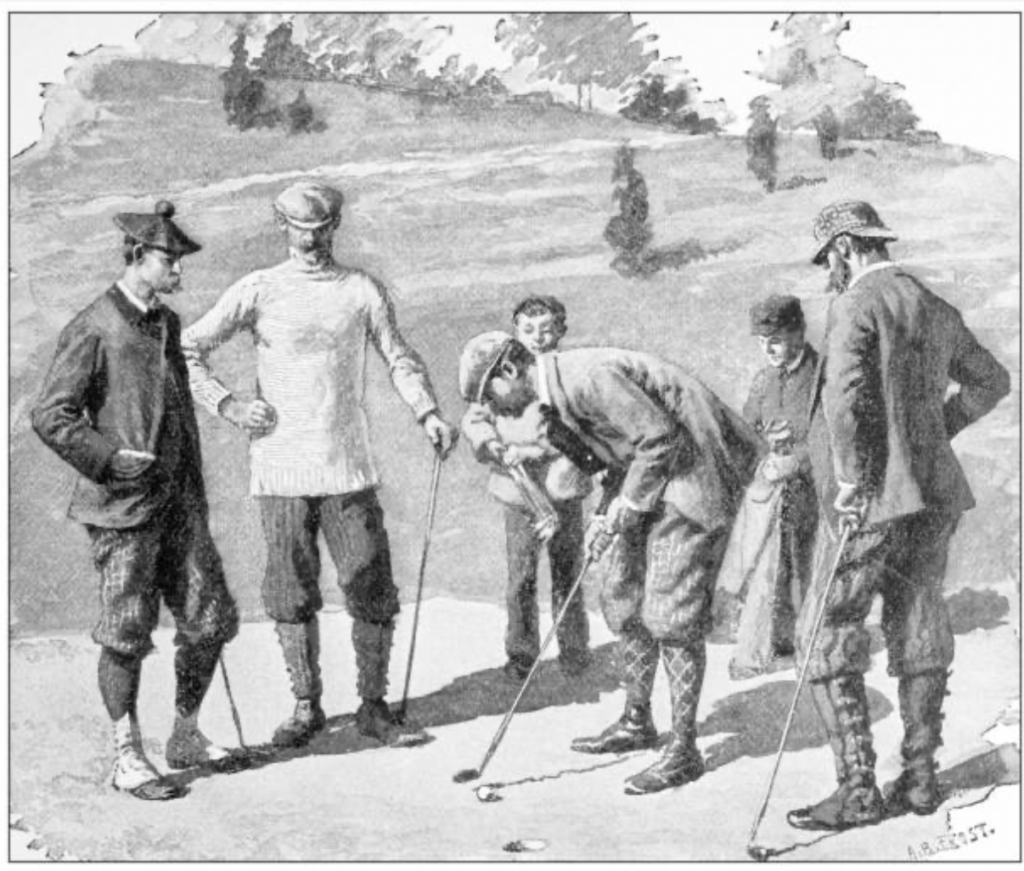Golf, often described as ‘the gentleman’s game’, has a rich and intriguing history that spans centuries. Scholars generally agree that golf began in Scotland however, who knows how long humans have hit round objects with sticks? It’s a satisfying diversion that can be immensely relaxing (and sometimes frustrating). In 1261, a Flemish poet mentions a ball game with a ‘kolf’ (Dutch for ‘club’). But golf is generally considered to have begun in Scotland in the Middle Ages, with bored shepherds hitting pebbles over sand dunes with their crooks.

Golf’s Irresistible Popularity
Golf in Scotland was known as ‘kolf’ (instead of ‘crummack’, ‘kebbie’ or another word for a shepherd’s crook) which does hint at some Dutch influence. The name morphed into ‘goff’ in late 14th-century Scottish dialect, and later, ‘golf’.
As more people became enamored of the game, the first official golf course was established in St. Andrews on the Scottish coast, in the early 15th century. The game became ‘too popular’ according to King James II. He banned golf in 1457, worried it was distracting men from their archery. This ban stayed in place until 1502, when King James IV gave in – and became a golfer himself.
In 1754, the Royal and Ancient Golf Club was founded next to the Old Course in St Andrews. This legendary club is still the mecca of the golf world, governing golf’s rules everywhere except the USA.
The Evolution of Golf
Golf spread rapidly in the 18th and 19th centuries, especially among wealthy gentlemen (the hand-crafted clubs and balls were very expensive). The introduction of the gutta-percha ball in the mid-19th century revolutionized the sport. This durable ball was less expensive, and resistant to water (helpful for those who can’t avoid the water hazards!). Other balls were developed over the years, including the Bramble, which had a dimpled pattern similar to today’s golf balls.
The 20th century brought us iconic golf heroes like Bobby Jones, Ben Hogan, Arnold Palmer, and Jack Nicklaus, while televised tournaments expanded the game’s popularity. Today, golf is a global phenomenon with millions of players and fans. Advanced technology is enhancing the game.

Montenegro’s Royal Golf Love Story
Montenegro holds a unique place in golf history, a tale that seamlessly entwines the region’s first golf club and an enchanting royal love story.
Montenegro’s Crown Prince Danilo I Petrovic met his future bride in St Petersburg in 1899, when her name was Duchess Jutta of Mecklenburg-Strelitz, Princess of Mecklenburg-Strelitz in northern Germany. She and Danilo embarked on a whirlwind romance, culminating in marriage just two weeks later. She converted to the Orthodox faith, adopted the name Milica, and moved to Montenegro, where she was warmly embraced by her new family and the Montenegrin people.
A Royal Tee Shot
In 1906, Montenegro’s first golf club was founded in the royal capital of Cetinje. As a supporter of the club, Crown Princess Milica was given the honour of striking the inaugural golf ball in the club’s first tournament. The event, attended by King Nikola Petrovic and his wife, welcomed representatives from around the world. People later recalled the vivid spectacle: champagne flowed, military music filled the air, and the day concluded with an elegant quadrille dance.
This golf club set a new precedent for the region. Decades later, golf clubs emerged in neighboring countries, such as Zagreb (1927), Belgrade (1936), and Slovenia (1938).
In her memoirs, Princess Milica described her adopted home as “a fairy tale from One Thousand and One Nights”. During her remarkable life, she was an active participant in Cetinje’s social scene, as well as a pioneer of golf in Montenegro. Crown Princess Milica Petrović played an important role in Montenegro’s pursuit of connecting this country to the Western world, with golf as a central element in this transformative endeavour. Her legacy extends to noble efforts during the First Balkan War, aiding the wounded, often at great personal risk.
Today, echoes of this unique chapter of golf in Montenegro continue to resonate, as the country’s golf legacy is about to grow again. Plans are underway for the opening of a golf academy in Luštica Bay in 2024, offering golf enthusiasts a distinctive place to hone their skills.
This new chapter in Montenegro’s golf history includes a 9-hole hilltop golf course opening at Lustica Bay in 2026, becoming an 18-hole golf course in 2028, with remarkable views over the Adriatic Sea and Boka Bay. The vision also includes impressive golf neighbourhoods joining this sophisticated resort town.

The love story that kickstarted golf in this picturesque nation is set to evolve into a national love affair with the sport, as Lustica Bay becomes a modern golfing destination, attracting golfers from all corners of the world. The future of golf in Montenegro looks bright, thanks to the sport’s timeless allure, which transcends borders and eras.


